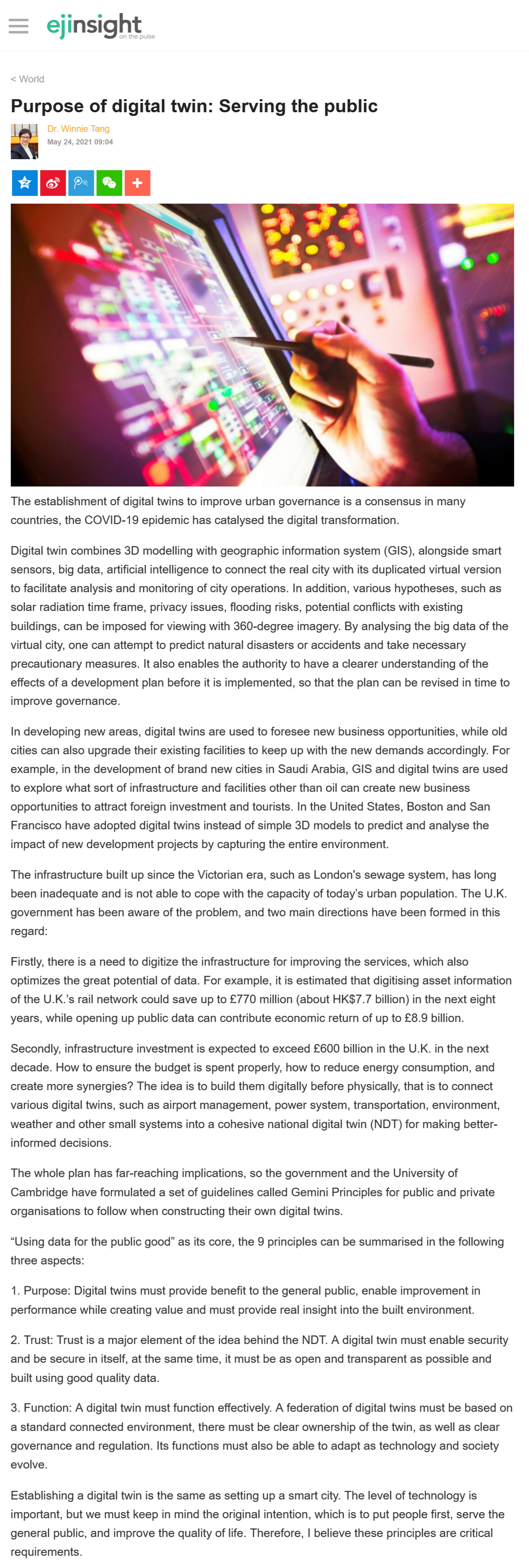網上版請按此

Purpose of digital twin: Serving the public
The establishment of digital twins to improve urban governance is a consensus in many countries, the COVID-19 epidemic has catalysed the digital transformation.
Digital twin combines 3D modelling with geographic information system (GIS), alongside smart sensors, big data, artificial intelligence to connect the real city with its duplicated virtual version to facilitate analysis and monitoring of city operations. In addition, various hypotheses, such as solar radiation time frame, privacy issues, flooding risks, potential conflicts with existing buildings, can be imposed for viewing with 360-degree imagery. By analysing the big data of the virtual city, one can attempt to predict natural disasters or accidents and take necessary precautionary measures. It also enables the authority to have a clearer understanding of the effects of a development plan before it is implemented, so that the plan can be revised in time to improve governance.
In developing new areas, digital twins are used to foresee new business opportunities, while old cities can also upgrade their existing facilities to keep up with the new demands accordingly. For example, in the development of brand new cities in Saudi Arabia, GIS and digital twins are used to explore what sort of infrastructure and facilities other than oil can create new business opportunities to attract foreign investment and tourists. In the United States, Boston and San Francisco have adopted digital twins instead of simple 3D models to predict and analyse the impact of new development projects by capturing the entire environment.
The infrastructure built up since the Victorian era, such as London's sewage system, has long been inadequate and is not able to cope with the capacity of today's urban population. The U.K. government has been aware of the problem, and two main directions have been formed in this regard:
Firstly, there is a need to digitize the infrastructure for improving the services, which also optimizes the great potential of data. For example, it is estimated that digitising asset information of the U.K.'s rail network could save up to £770 million (about HK$7.7 billion) in the next eight years, while opening up public data can contribute economic return of up to £8.9 billion.
Secondly, infrastructure investment is expected to exceed £600 billion in the U.K. in the next decade. How to ensure the budget is spent properly, how to reduce energy consumption, and create more synergies? The idea is to build them digitally before physically, that is to connect various digital twins, such as airport management, power system, transportation, environment, weather and other small systems into a cohesive national digital twin (NDT) for making better-informed decisions.
The whole plan has far-reaching implications, so the government and the University of Cambridge have formulated a set of guidelines called Gemini Principles for public and private organisations to follow when constructing their own digital twins.
"Using data for the public good" as its core, the 9 principles can be summarised in the following three aspects:
1. Purpose: Digital twins must provide benefit to the general public, enable improvement in performance while creating value and must provide real insight into the built environment.
2. Trust: Trust is a major element of the idea behind the NDT. A digital twin must enable security and be secure in itself, at the same time, it must be as open and transparent as possible and built using good quality data.
3. Function: A digital twin must function effectively. A federation of digital twins must be based on a standard connected environment, there must be clear ownership of the twin, as well as clear governance and regulation. Its functions must also be able to adapt as technology and society evolve.
Establishing a digital twin is the same as setting up a smart city. The level of technology is important, but we must keep in mind the original intention, which is to put people first, serve the general public, and improve the quality of life. Therefore, I believe these principles are critical requirements.
Dr. Winnie Tang
Adjunct Professor, Department of Computer Science, Faculty of Engineering; Department of Geography, Faculty of Social Sciences; and Faculty of Architecture, The University of Hong Kong